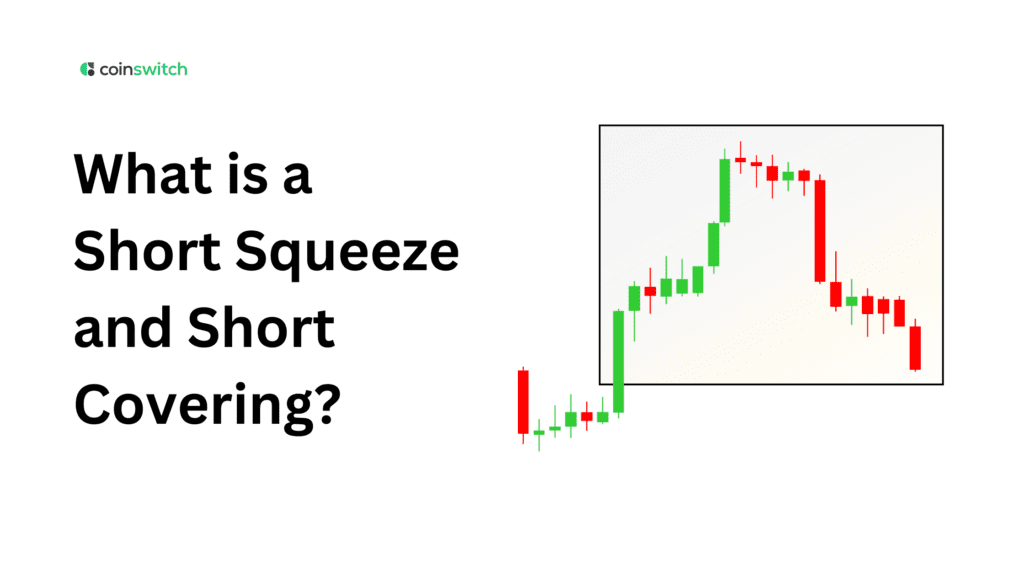Understanding Short Squeeze
When traders bet that the price of a stock or crypto will fall, they “short” it. In essence, shorting, or short selling, means borrowing the asset, selling it at the current market price, and hoping to buy it back later at a lower price to return it to the lender.
But if the price instead rises rapidly, those traders get squeezed and will be forced to buy back at higher prices, driving the price up further in a feedback loop. That situation is called a short squeeze. Think of a short squeeze as a trap set by the market. Shorts are crowded, prices spike, and then panic becomes the engine. Squeezes often catch traders off guard and can deliver sharp, explosive gains in a short period of time.
The Mechanics of a Short Squeeze
How does a short squeeze unfold? It works like this:
First, many traders build short positions. They borrow and sell, expecting to buy back at a cheaper price. The market perceives weakness, sellers pile in, and the price begins to fall—or stays flat. That gives short sellers confidence.
Then comes the twist. A catalyst—positive news, a large buy order, a key development—pushes the price up. Short sellers face increasing losses. Many have defined margins and liquidation levels. As price moves up, positions get liquidated (forced to buy back). Others, seeing losses mount, start to cover (buy back to close their shorts). That buying pressure pushes the price even higher, triggering more cover, more liquidations, and the squeeze snowballs.
Because it all happens quickly, and because many shorts unwind in the same direction, the market’s momentum accelerates upward. The squeeze feeds itself until most shorts are out or the rally exhausts.
In formula: rising price → forced buying by shorts → more price rise → more forced buying… until equilibrium returns or buyers run out of fuel.
Read More: How to use chart patterns to make trading decisions?
Causes of a Short Squeeze
Several conditions make a short squeeze possible:
- High short interest: When a large percentage of a coin’s available supply is sold short, it sets the stage. The more shorts that need to be covered, the higher the potential squeeze.
- Low float or low liquidity: When there are not many coins or tokens freely trading, even modest buying pressure can trigger large price moves.
- Catalyst or news trigger: A positive news, partnerships, hack reversals, regulatory clarity—anything that flips sentiment can trigger the squeeze.
- Margin calls and liquidations: When short positions have borrowing or margin requirements, rising prices activate liquidation thresholds, forcing buybacks.
- Panic and fear among short sellers: As losses mount, many cover early to preserve capital, accelerating the upward movement.
Put together, a short squeeze is a perfect storm: too many shorts, little available liquidity, and a spark that changes sentiment.
Risks and Considerations
Short squeezes are dangerous for both short sellers and long buyers.
For shorts: Losses can be unlimited. If the price keeps rising, you may end up buying back at much higher levels than your entry. Heavy forced cover spikes your cost.
For buyers entering late: The squeeze often runs out of gas. Prices may overshoot and collapse quickly. If you jump in near the top, you risk being part of the blow-off phase.
Volatility and slippage: In fast squeezes, execution prices deviate from expected ones. Slippage can sting.
Liquidity exhaustion: The squeeze might run out of counterparties to buy or sell against. Once demand fades, sharp reversals follow.
False squeezes/traps: Some moves resemble squeezes but lack real short interest backing; they collapse fast. Jumping without evidence of genuine short covering can be dangerous.
Emotional traps and FOMO: Observers see the jump, fear missing out, and buy in blindly. That often leads to losses once the squeeze phase ends.
Short squeezes reward timing and bravery—but punish rash entry.
Short Squeeze in the Crypto Market
Crypto markets are especially vulnerable to short squeezes because of extreme volatility, thinner liquidity in altcoins, and leverage-enabled derivatives.
Take a meme coin with 20% of its supply sold short via futures or perpetuals. If a tweet or listing triggers a buy wave, short sellers scramble to exit, fueling the rally. The chain reaction is magnified by leveraged liquidations.
For example, a coin trading at $1 might spike to $3 in hours—partially due to buyers, partially due to forced short covering. If many shorts use high leverage, their margin will break faster, triggering more forced buys.
On many crypto exchanges, liquidation cascades happen rapidly. One person’s margin loss can set off a chain of liquidations across multiple accounts, magnifying the upward pressure. Because crypto trades 24/7 without pause, squeezes don’t get “cool off” breaks. Momentum builds continuously.
Given this, certain smaller, low-market-cap cryptos see squeezes more often than blue chips. But even BTC or ETH can experience localized squeezes in derivatives markets.
Read More: How to use the spinning top candlestick pattern to trade crypto
Understanding Short Covering
Short covering refers to the act of buying back the asset you previously sold short. It is the final step in a short-selling strategy, which is a bet that a security’s price will decline. When you have a short position, covering closes out the short — you buy back the same amount you borrowed, repay it, and settle your debt.
Covering is usually triggered by fear or forced conditions: when losses grow, when margin calls hit, or when liquidations happen. It is a necessary step for shorts to escape their position.
In many short squeezes, short covering is what fuels the squeeze. As shorts close positions by buying the asset, they push the price upward—ironically helping those they bet against.
Covering can occur gradually or quickly in panic. It can be voluntary (you decide to do it to stop losses) or involuntary (when the exchange liquidates your position).
An Example of Short Covering

Imagine you short 100 tokens of CoinX at $10. You sell borrowed tokens, pocket $1,000. You expect the price to drop to $7, so you can buy back and keep the difference.
But instead, news breaks: CoinX gets listed on a major exchange. Price begins climbing. At $11, you’re losing. At $12, your margin account warns. At $12.50, your position is liquidated—the exchange buys back 100 tokens at $12.50, costing you $1,250. You lost $250. That forced buyback is covering.
Alternatively, you might see early signs at $11.50 and voluntarily cover — buying back 100 tokens at $11.50 to close your short position, accepting a smaller loss but avoiding worse. That’s short covering in action.
Conclusion
Short squeeze and short covering are two sides of the same coin: one a market phenomenon, the other the mechanism by which the phenomenon accelerates. A short squeeze is when rising prices force shorts to buy back, causing a further price rise. Short covering is the act of buying back and closing out a short position.
In crypto, these events replay often—especially in overheated or leveraged markets. Understanding when a squeeze is likely, identifying high short interest, monitoring liquidity, and knowing when to cover or join are skills, not luck.
Squeezes can be spectacular and profitable—but entering late is dangerous. Covering must be strategic. Between the two, the real winners are those who plan ahead, act quickly, and acknowledge the volatility that powers them.
FAQs
1. What does short covering mean?
Short covering means buying back the asset you borrowed and sold short to close your short position.
2. Is short covering bullish or bearish?
Short covering is generally bullish—because it involves buying, which drives the price upward. In a short squeeze, that buying adds fuel to the rally.
3. Who benefits from short covering?
Short covering benefits those already holding the asset (longs) because covering raises the price. It also benefits short sellers who escape with reduced losses before worse damage.
4. What is the difference between short and cover?
To “short” means to open a position by borrowing and selling an asset, betting its price will fall. To “cover” means to close that position by buying back and returning the borrowed asset, realizing a profit or loss.








